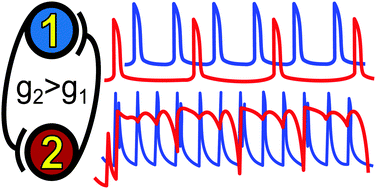Pulse-coupled BZ oscillators with unequal coupling strengths†
Abstract
Coupled chemical oscillators are usually studied with symmetric coupling, either between identical oscillators or between oscillators whose frequencies differ. Asymmetric connectivity is important in neuroscience, where synaptic strength inequality in neural networks commonly occurs. While the properties of the individual oscillators in some coupled chemical systems may be readily changed, enforcing inequality between the connection strengths in a reciprocal coupling is more challenging. We recently demonstrated a novel way of coupling chemical oscillators, which allows for manipulation of individual connection strengths. Here we study two identical, pulse-coupled Belousov–Zhabotinsky (BZ) oscillators with unequal connection strengths. When the pulse perturbations contain KBr (inhibitor), this system exhibits simple out-of-phase and complex oscillations, oscillatory-suppressed states as well as temporally periodic patterns (N : M) in which the two oscillators exhibit different numbers of peaks per cycle. The N : M patterns emerge due to the long-term effect of the inhibitory pulse-perturbations, a feature that has not been considered in earlier works. Time delay was previously shown to have a profound effect on the system’s behaviour when pulse coupling was inhibitory and the coupling strengths were equal. When the coupling is asymmetric, however, delay produces no qualitative change in behaviour, though the 1 : 2 temporal pattern becomes more robust. Asymmetry in instantaneous excitatory coupling via AgNO3 injection produces a previously unseen temporal pattern (1 : N patterns starting with a double peak) with time delay and high [AgNO3]. Numerical simulations of the behaviour agree well with theoretical predictions in asymmetrical pulse-coupled systems.


 Please wait while we load your content...
Please wait while we load your content...